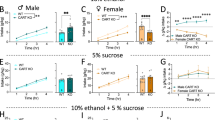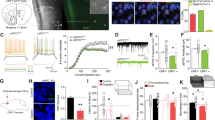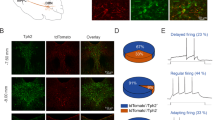Abstract
We studied the involvement of cocaine- and amphetamine-regulated transcript peptide (CART) in the central nucleus of amygdala (CeA), lateral bed nucleus of the stria terminalis (BNSTl) and nucleus accumbens shell (AcbSh) in generation of ethanol withdrawal symptoms, with particular focus on anxiety-like behavior using a social interaction test. Administration of CART (54–102) into the lateral ventricle (50 and 100 ng) and bilaterally in the CeA (10 and 20 ng) caused a significant reduction in social interaction, suggesting an anxiogenic action of the peptide. Chronic ethanol treatment for 15 days followed by withdrawal precipitated an anxiogenic response at 24 h that was attenuated by intracerebroventricular (5 μl) and intra-CeA (1 μl) administration of antibodies against CART (1 : 500 dilution). An immunocytochemistry protocol was employed to study the response of the endogenous CART system in the CeA following chronic ethanol withdrawal. At 0 h ethanol withdrawal, CART immunoreactivity was apparent in few fibers and the profile was similar to that in the pair-fed control rats. Twenty-four hours following ethanol withdrawal, a highly significant increase (P<0.001) in CART immunoreactivity was noticed in the CeA, which returned to normal 48 and 72 h post-withdrawal. Similar doses of CART or CART antibody injected bilaterally into the BNSTl or AcbSh produced no response in the social interaction test. Furthermore, the CART immunoreactivity profile did not change at the post-withdrawal time points in each of these brain sites. We suggest that CART may mediate the early signs of anxiety-like behavior induced by ethanol withdrawal within the neuroanatomical framework of the CeA.
Similar content being viewed by others
Log in or create a free account to read this content
Gain free access to this article, as well as selected content from this journal and more on nature.com
or
References
Adolphs R, Tranel D, Damasio H, Damasio A (1994). Impaired recognition of emotion in facial expressions following bilateral damage to the human amygdala. Nature 372: 669–672.
Asakawa A, Inui A, Yuzuriha H, Nagata T, Kaga T, Ueno N et al (2001). Cocaine-amphetamine-regulated transcript influences energy metabolism, anxiety and gastric emptying in mice. Horm Metab Res 33: 554–558.
Bannon AW, Seda J, Carmouche M, Francis JM, Jarosinski MA, Douglass J (2001). Multiple behavioral effects of cocaine- and amphetamine-regulated transcript (CART) peptides in mice: CART 42–89 and CART 49–89 differ in potency and activity. J Pharmacol Exp Ther 299: 1021–1026.
Barsh GS, Schwartz MW (2002). Genetic approaches to studying energy balance: perception and integration. Nat Rev Genet 3: 589–600.
Chaki S, Kawashima N, Suzuki Y, Shimazaki T, Okuyama S (2003). Cocaine- and amphetamine-regulated transcript peptide produces anxiety-like behavior in rodents. Eur J Pharmacol 464: 49–54.
Couceyro PR, Koylu EO, Kuhar MJ (1997). Further studies on the anatomical distribution of CART by in situ hybridisation. J Chem Neuroanat 12: 229–241.
Criado JR, Morales M (2000). Acute ethanol induction of c-Fos immunoreactivity in pre-pro-enkephalin expressing neurons of the central nucleus of the amygdala. Brain Res 861: 173–177.
Douglass J, McKinzie AA, Couceyro P (1995). PCR differential display identifies a rat brain mRNA that is transcriptionally regulated by cocaine and amphetamine. J Neurosci 15: 2471–2481.
Elias CF, Lee C, Kelly J, Aschkenasi C, Ahima RS, Couceyro PR et al (1998). Leptin activates hypothalamic CART neurons projecting to the spinal cord. Neuron 21: 1375–1385.
Eskay RL, Giraud P, Oliver C, Brown-Stein MJ (1979). Distribution of alpha-melanocyte-stimulating hormone in the rat brain: evidence that alpha-MSH-containing cells in the arcuate region send projections to extra-hypothalamic areas. Brain Res 178: 55–67.
File SE, Hyde JR (1978). Can social interaction be used to measure anxiety? Br J Pharmacol 62: 19–24.
Funk CK, O' Dell LE, Crawford EF, Koob GF (2006). Corticotropin-releasing factor within the central nucleus of the amygdala mediates enhanced ethanol self-administration in withdrawn, ethanol-dependent rats. J Neurosci 26: 11324–11332.
Gautvik KM, de Lecea L, Gautvik VT, Danielson PE, Tranque P, Dopazo A et al (1996). Overview of the most prevalent hypothalamus-specific mRNAs, as identified by directional tag PCR subtraction. Proc Natl Acad Sci USA 93: 8733–8738.
Gonzalez LE, File SE, Overstreet DH (1998). Selectively bred lines of rats differ in social interaction and hippocampal 5-HT1A receptor function: a link between anxiety and depression? Pharmacol Biochem Behav 59: 787–792.
Goyal SN, Kokare DM, Chopde CT, Subhedar NK (2006). Alpha-melanocyte stimulating hormone antagonizes antidepressant-like effect of neuropeptide Y in Porsolt's test in rats. Pharmacol Biochem Behav 85: 369–377.
Jung SK, Hong MS, Suh GJ, Jin SY, Lee HJ, Kim BS et al (2004). Association between polymorphism in intron 1 of cocaine- and amphetamine-regulated transcript gene with alcoholism, but not with bipolar disorder and schizophrenia in Korean population. Neurosci Lett 365: 54–57.
Kask A, Schioth HB, Mutulis F, Wikberg JE, Rago L (2000). Anorexigenic cocaine- and amphetamine-regulated transcript peptide intensifies fear reactions in rats. Brain Res 857: 283–285.
Knapp DJ, Overstreet DH, Moy SS, Breese GR (2004). SB242084, flumazenil, and CRA1000 block ethanol withdrawal-induced anxiety in rats. Alcohol 32: 101–111.
Kokare DM, Chopde CT, Subhedar NK (2006). Participation of α-melanocyte stimulating hormone in ethanol-induced anxiolysis and withdrawal anxiety in rats. Neuropharmacology 51: 536–545.
Kokare DM, Dandekar MP, Chopde CT, Subhedar N (2005). Interaction between neuropeptide Y and alpha-melanocyte stimulating hormone in amygdala regulates anxiety in rats. Brain Res 1043: 107–114.
Koob GF (1992). Drugs of abuse: anatomy, pharmacology and function of reward pathways. Trends Pharmacol Sci 13: 177–184.
Koob GF (2003a). Alcoholism: allostasis and beyond. Alcohol Clin Exp Res 27: 232–243.
Koob GF (2003b). Neuroadaptive mechanisms of addiction: studies on the extended amygdala. Eur Neuropsychopharmacol 13: 442–452.
Koob GF, Le Moal M (1997). Drug abuse: hedonic homeostatic dysregulation. Science 278: 52–58.
Koylu EO, Couceyro PR, Lambert PD, Kuhar MJ (1998). Cocaine- and amphetamine-regulated transcript peptide immunohistochemical localization in the rat brain. J Comp Neurol 391: 115–132.
Koylu EO, Couceyro PR, Lambert PD, Ling NC, DeSouza EB, Kuhar MJ (1997). Immunohistochemical localization of novel CART peptides in rat hypothalamus, pituitary and adrenal gland. J Neuroendocrinol 9: 823–833.
Kristensen P, Judge ME, Thim L, Ribel U, Christjansen KN, Wulff BS et al (1998). Hypothalamic CART is a new anorectic peptide regulated by leptin. Nature 393: 72–76.
Kuhar MJ, Adams S, Dominguez G, Jaworski J, Balkan B (2002). CART peptides. Neuropeptides 36: 1–8.
Kuhar MJ, Dall Vechia SE (1999). CART peptides: novel addiction and feeding-related neuropeptides. Trends Neurosci 22: 316–320.
Kuhar MJ, Yoho LL (1999). CART peptide analysis by Western blotting. Synapse 33: 163–171.
LeDoux JE, Iwata J, Cicchetti P, Reis DJ (1988). Different projections of the central amygdaloid nucleus mediate autonomic and behavioral correlates of conditioned fear. J Neurosci 8: 2517–2529.
Merlo Pich E, Lorang M, Yeganeh M, Rodriguez de Fonseca F, Raber J, Koob GF et al (1995). Increase of extracellular corticotropin-releasing factor-like immunoreactivity levels in the amygdala of awake rats during restraint stress and ethanol withdrawal as measured by microdialysis. J Neurosci 15: 5439–5447.
Moller C, Wiklund L, Sommer W, Thorsell A, Heilig M (1997). Decreased experimental anxiety and voluntary ethanol consumption in rats following central but not basolateral amygdala lesions. Brain Res 760: 94–101.
O'Donohue TL, Miller RL, Jacobowitz DM (1979). Identification, characterization and stereotaxic mapping of intraneuronal alpha-melanocyte stimulating hormone-like immunoreactive peptides in discrete regions of the rat brain. Brain Res 176: 101–123.
Olive MF, Koenig HN, Nannini MA, Hodge CW (2002). Elevated extracellular CRF levels in the bed nucleus of the stria terminalis during ethanol withdrawal and reduction by subsequent ethanol intake. Pharmacol Biochem Behav 72: 213–220.
Pandey SC (2004). The gene transcription factor cyclic AMP-responsive element binding (CREB) protein: role in positive and negative affective states of alcohol addiction. Pharmacol Ther 104: 47–58.
Pandey SC, Roy A, Zhang H (2003). The decreased phosphorylation of cyclic adenosine monophosphate (cAMP) response element binding (CREB) protein in the central amygdala acts as a molecular substrate for anxiety related to ethanol withdrawal in rats. Alcohol Clin Exp Res 27: 396–409.
Pandey SC, Zhang D, Mittal N, Nayyar D (1999). Potential role of the gene transcription factor cyclic AMP-responsive element binding protein in ethanol withdrawal-related anxiety. J Pharmacol Exp Ther 288: 866–878.
Paxinos G, Watson C (1998). The Rat Brain in Stereotaxic Coordinates. Academic Press: London.
Sakharkar AJ, Singru PS, Sarkar K, Subhedar NK (2005). Neuropeptide Y in the forebrain of the adult male cichlid fish Oreochromis mossambicus: distribution, effects of castration and testosterone replacement. J Comp Neurol 489: 148–165.
Salinas A, Wilde JD, Maldve RE (2006). Ethanol enhancement of cocaine- and amphetamine-regulated transcript mRNA and peptide expression in the nucleus accumbens. J Neurochem 97: 408–415.
Scruggs P, Dun SL, Dun NJ (2003). Cocaine- and amphetamine-regulated transcript peptide attenuates phenylephrine-induced bradycardia in anesthetized rats. Am J Physiol Regul Integr Comp Physiol 285: R1496–R1503.
Singru PS, Sanchez E, Fekete C, Lechan RM (2007). Importance of melanocortin signaling in refeeding-induced neuronal activation and satiety. Endocrinology 148: 638–646.
Smith SM, Vaughan JM, Donaldson CJ, Rivier J, Li C, Chen A et al (2004). Cocaine- and amphetamine-regulated transcript activates the hypothalamic-pituitary-adrenal axis through a corticotropin-releasing factor receptor-dependent mechanism. Endocrinology 145: 5202–5209.
Smith Y, Kieval J, Couceyro PR, Kuhar MJ (1999). CART peptide-immunoreactive neurones in the nucleus accumbens in monkeys: ultrastructural analysis, colocalization studies, and synaptic interactions with dopaminergic afferents. J Comp Neurol 407: 491–511.
Stanek LM (2006). Cocaine- and amphetamine-related transcript (CART) and anxiety. Peptides 27: 2005–2011.
Thim L, Kristensen P, Nielsen PF, Wulff BS, Clausen JT (1999). Tissue-specific processing of cocaine- and amphetamine-regulated transcript peptides in the rat. Proc Natl Acad Sci USA 96: 2722–2727.
Thim L, Nielsen PF, Judge ME, Andersen AS, Diers I, Egel-Mitani M et al (1998). Purification and characterization of a new hypothalamic satiety peptide, cocaine and amphetamine regulated transcript (CART), produced in yeast. FEBS Lett 428: 263–268.
Tian DR, Li XD, Shi YS, Wan Y, Wang XM, Chang JK et al (2004). Changes of hypothalamic alpha-MSH and CART peptide expression in diet-induced obese rats. Peptides 25: 2147–2153.
Vicentic A, Jones DC (2007). The CART (cocaine- and amphetamine-regulated transcript) system in appetite and drug addiction. J Pharmacol Exp Ther 320: 499–506.
Vrang N, Larsen PJ, Clausen JT, Kristensen P (1999). Neurochemical characterization of hypothalamic cocaine-amphetamine-regulated transcript neurons. J Neurosci 19: RC5.
Walker DL, Davis M (1997). Double dissociation between the involvement of the bed nucleus of the stria terminalis and the central nucleus of the amygdala in startle increases produced by conditioned versus unconditioned fear. J Neurosci 17: 9375–9383.
Wittmann G, Liposits Z, Lechan RM, Fekete C (2005). Origin of cocaine- and amphetamine-regulated transcript-containing axons innervating hypophysiotropic corticotropin-releasing hormone-synthesizing neurons in the rat. Endocrinology 146: 2985–2991.
Yermolaieva O, Chen J, Couceyro PR, Hoshi T (2001). Cocaine- and amphetamine-regulated transcript peptide modulation of voltage gated Ca2+ signaling in hippocampal neurons. J Neurosci 21: 7474–7480.
Zhang H, Pandey SC (2003). Effects of PKA modulation on the expression of neuropeptide Y in rat amygdaloid structures during ethanol withdrawal. Peptides 24: 1397–1402.
Acknowledgements
Supported by the Grant from the Department of Science and Technology (SP/SO/C-39/99), Govt of India, New Delhi, India.
Author information
Authors and Affiliations
Corresponding author
Additional information
DISCLOSURE/CONFLICT OF INTEREST
The author(s) (MPD, PSS, DMK, RML, JJC, NS) declare that, except for income received from their primary employer, no financial support or compensation has been received from any individual or corporate entity over the past three years for research or professional service and there are no personal financial holdings that could be perceived as constituting a potential conflict of interest. The author, LT is employed by and has equity interest with Novo Nordisk A/S, Denmark.
Supplementary Information accompanies the paper on the Neuropsychopharmacology website (http://www.nature.com/npp)
Supplementary information
Rights and permissions
About this article
Cite this article
Dandekar, M., Singru, P., Kokare, D. et al. Importance of Cocaine- and Amphetamine-Regulated Transcript Peptide in the Central Nucleus of Amygdala in Anxiogenic Responses Induced by Ethanol Withdrawal. Neuropsychopharmacol 33, 1127–1136 (2008). https://doi.org/10.1038/sj.npp.1301516
Received:
Revised:
Accepted:
Published:
Issue date:
DOI: https://doi.org/10.1038/sj.npp.1301516
Keywords
This article is cited by
-
Cocaine and amphetamine regulated transcript (CART) signalling in the central nucleus of the amygdala modulates stress-induced alcohol seeking
Neuropsychopharmacology (2021)
-
CART neurons in the lateral hypothalamus communicate with the nucleus accumbens shell via glutamatergic neurons in paraventricular thalamic nucleus to modulate reward behavior
Brain Structure and Function (2017)
-
Central regulation of feeding behavior during social isolation of rat: evidence for the role of endogenous CART system
International Journal of Obesity (2011)
-
Cocaine- and Amphetamine-Regulated Transcript Peptide Plays a Role in the Manifestation of Depression: Social Isolation and Olfactory Bulbectomy Models Reveal Unifying Principles
Neuropsychopharmacology (2009)
-
Expression of CART Peptide in the Paleoamygdala Neurons and Its Relationship with Sex Hormone Levels
Bulletin of Experimental Biology and Medicine (2009)



